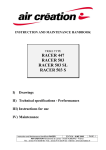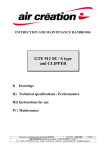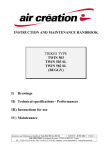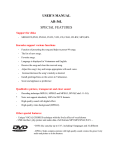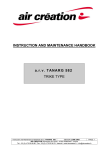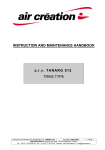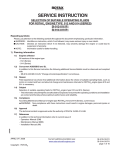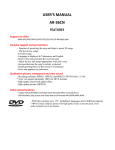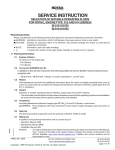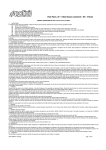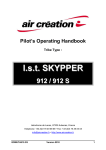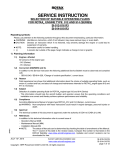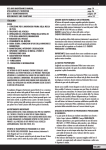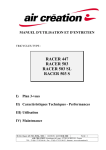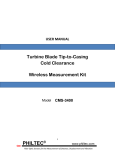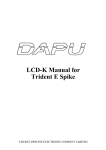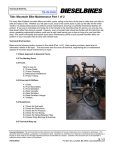Download iFun 13 Pixel Instruction and Maintenance Manual
Transcript
INSTRUCTION AND MAINTENANCE HANDBOOK TRIKE TYPES Pixel 200 Pixel 250 I) 3-view Drawings II) Technical specifications - Performance III) Utilisation IV) Maintenance Version 0010 PAGE : 1 GDMANPixel-1G AIR CREATION Aérodrome de Lanas - 07200 AUBENAS - France Tél. : 33 (0) 4 75 93 66 66 - Fax : 33 (0) 4 75 35 04 03 - Internet : www.aircreation.fr I) Drawings Version 0010 PAGE : 2 GDMANPixel-1G AIR CREATION Aérodrome de Lanas - 07200 AUBENAS - France Tél. : 33 (0) 4 75 93 66 66 - Fax : 33 (0) 4 75 35 04 03 - Internet : www.aircreation.fr II) Technical Specifications Pixel 200 Pixel 250 Empty weight (without options) 54 kg - 119 lbs 58 kg - 128 lbs Max weight with iFun 13 wing 169 kg - 373 lbs 199 kg- 439 lbs Max payload with iFun 13 wing 115 kg - 254 lbs 140 kg- 309 lbs Max pilot weight 110 kg – 242 lbs 110 kg – 242 lbs Ultimate load factors at max weight +6g / -3g +6g / -3g Limit load factors +4g / 0g +4g / 0g Fuel tank 16 l (4.2 US Gal) 16 l (4.2 US Gal) Engine Polini THOR 200 Polini THOR 250 Max. power 29 HP 36 HP Max. rpm 8000 7400 Reduction gear Mechanical Mechanical Reduction ratio 1/2.8 1/2.8 Max. propeller rpm 2,857 2,650 Measured noise level Lm at max. wt - max. rpm 82dB 79dB Corrected noise level Lr 83dB 80dB At height h 25 m 30 m Version 0010 PAGE : 3 GDMANPixel-1G AIR CREATION Aérodrome de Lanas - 07200 AUBENAS - France Tél. : 33 (0) 4 75 93 66 66 - Fax : 33 (0) 4 75 35 04 03 - Internet : www.aircreation.fr III) Instructions for use a) Retrofits The Pixel trike is designed to be used with the single-seater wing iFun 13 of our production. To install a wing of another brand, check all parameters (height, displacement of the control bar, propeller clearance with keel end) and make sure that there is at least 10cm clearance between the propeller and the wing structure, in all possible angles of attack and angles of bank with the hang point in its most forward position. b) Assembling Assemble the wing, perform the pre-flight check as indicated in its manual, positioning it on the nose and into the wind. Wheel the trike behind the wing and line it up with the keel. Raise the upper beam, push the hang point into the hang bracket, position the Ø10mm bolt and install the butterfly nut, tilt the lever back in order to tighten the plates, and secure with the safety ring. Slip the back-up fastening cable into the belt loop at the king post, running it once around it. Slip it through the belt loop again and fasten it to the trike beam. The back-up fastening cable should be run under the tensioning cables. This operation secures the trike to the wing, also securing the wing cross-bar tensioning system. Place the propeller to a horizontal position. Raise the wing nose in a horizontal position. Attach the front strut between the aluminum flanges at the top of the upper beam using the bolt and the butterfly nut. Pick up the 'A' frame tubes, take hold of the control bar and lift the wing while keeping the trike from falling over or backwards. The front strut can be fitted into the opening at the front of the lower beam when the wing is lifted high enough. When alone, rotate the instrument panel (if equipped) on the seat, sit down on the trike keel facing the 'A' frame, take hold of the control bar, place it on your knees, raise the wing and fit the front strut as indicated. Install the upper beam safety bolt at the engine support using the butterfly and safety ring, then install the front strut fastening bolt to the lower trike beam at the fork. Secure with the safety ring. Rotate the instrument panel (if equipped) against the front tube and install the windshield by means of the 1/4-turn screws. Install the foam seat upholstery using the Velcro tabs. Dismantling is carried out in reverse order of the assembling operations. Version 0010 PAGE : 4 GDMANPixel-1G AIR CREATION Aérodrome de Lanas - 07200 AUBENAS - France Tél. : 33 (0) 4 75 93 66 66 - Fax : 33 (0) 4 75 35 04 03 - Internet : www.aircreation.fr c) Preflight-check Check the wing as indicated in its operating manual. Check the trike-to-wing attachments and their safety devices. Check the front strut attachment to the lower and upper beams. Check the safety bolt on the upper beam-to-engine mount. Check condition of propeller and its mounting screw, exhaust and exhaust fasteners, air filters and rubber mounts. Check the cooling liquid level, the condition of the hoses and their collars and of the radiator (only in the 250 version). Check fuel filter, fuel primer pump, the hose condition. d) Trike and engine operation Foot Throttle The power of the engine increases when you push the top of the right pedal forward. Hand throttle (version XC) Pushing the throttle lever forward increases power and pulling it back reduces power. Ground steering The steering bar operates the front wheel direction. Pushing on the right side will turn the aircraft to the left and vice versa. Brake Pushing the top of the left pedal forward operates the brake. Ignition switch The ignition switch is always set to ON. Shut down is obtained by pressing on the red button on the instrument panel, if equipped, or on the tachometer block in front of the seat frame if not. Starting Fill the tank with a mixture of premium petrol (GB) or gas(oline) (U.S.) and 100% synthetic oil in a percentage of 1.8 to 2. (Recommended oil – Yacco MVX 1000). Use the pump on the fuel hose to prime the engine. Use the choke located on the carburetor when the engine is cold. Sit in the trike. Set the throttle handle (if equipped) and the foot pedal to the “idle” position. WARNING: you must hear the throttle valve closing before starting the engine. Move the throttle pedal back and forth to check that the piston on each carburetor returns to idle position. If you do not hear this noise, the reason may be a wrong adjustment or the cables may be stuck. In these conditions, you may lose the control of the aircraft and cause a serious accident, or even death, due to the strong push after starting. Brake the front wheel by means of the lever fitted on the pedal. Version 0010 PAGE : 5 GDMANPixel-1G AIR CREATION Aérodrome de Lanas - 07200 AUBENAS - France Tél. : 33 (0) 4 75 93 66 66 - Fax : 33 (0) 4 75 35 04 03 - Internet : www.aircreation.fr Check that no one is in the radius of the propeller, and activate the electric starter (if equipped) or pull the handle of the starter located on the upper beam. The manual starter is equipped with a “Flash starter” system that facilitates start-up. Perform rapid pulls of the cord to “charge” the spring until start-up. Shut the command of the starter after a few seconds of power. Access on board The positions of the front fork are adaptable to fit every size of pilot. Four openings in the lower beam of the trike allow for the adjustment of the position of the fork and the command foot pedals. The alignment of the seat back may be adjusted by moving the upper strap of the seat bottom which can slide the frame by unscrewing the two blocking screws. The pocket located in the front of the seat may contain up to 3kg (6lbs) of material. The bag (optional) placed behind the seat back may contain up to 9kg 13lbs) of material and baggage. Prior to take-off Check the fuel level in the tank and the adjustable rear view mirror that allows the pilot to view the fuel level in flight. Fasten the seat belt like an automobile seat belt, check that the buckle is properly secured. WARNING: the safety belt should be placed at hip level. Safety belts fastened at abdominal level may cause internal lesions in the event of violent shock. Check that the control bar moves freely in roll and pitch axes. Release the parking brake by a short push on the brake pedal. Take-off Use full throttle for a short take off. Avoid reducing or cutting the engine below 100 m (328ft) altitude to avoid the dynamic stall that could result. Never take off with a fuel level of fewer than 5 l (1.3 gallons). Cruising Keep the aircraft level with the throttle between 1/4 and full depending on given airspeed and load. Avoid repeated and sudden power climbs and dives to prevent sudden engine temperature changes, which cause wear and tear. Checking the fuel level is done by looking in the rear view mirror located on the left side of the landing gear (right in the US). A landing should be performed when the fuel level is less than 3 l (0.8 gallons), allowing for no more than thirty minutes of flight at economic cruising speed. Landing The landing approach is best executed using the throttle pedal in order to keep both hands on the control bar. At maximum load, keep the throttle at 1/4 of full power when on finals to facilitate flare-out. Throttle back when the wheels touch the ground. Emergency Procedures Power failure on take-off Version 0010 PAGE : 6 GDMANPixel-1G AIR CREATION Aérodrome de Lanas - 07200 AUBENAS - France Tél. : 33 (0) 4 75 93 66 66 - Fax : 33 (0) 4 75 35 04 03 - Internet : www.aircreation.fr Should the power unit fail during take-off, and significant height should not have been gained, maintain flying approach speed, accompanying the diving movement of the wing, and land the aircraft straight ahead without attempting a return to the landing field. Power failure at altitude If the engine fails for any reason, prepare for and carry out the emergency landing procedure as follows: Immediately establish the best glide angle speed Check for a suitable landing sites. If possible, choose a number of preliminary options. Check pilot seat-belt. Check wind direction, either by natural indicators such as smoke rising or by judging drift of aircraft over the ground. Choose the most appropriate landing site. Set up an approach as far as possible into wind. Remember your aircraft cannot be heard. Check that no one is on the landing site. Finalize your approach, deciding upon the best landing to clear fences or other obstacles. Use a short landing technique. Engine fire: Should an engine fire occur during flight: Maintain your flying speed. Set ignition switch off. Carry out the emergency landing procedures in above. Leave the aircraft and move as far away as possible. e) Special Operating Conditions Load carriage, survey material, data transmission, photography, video etc. Install the loads to be carried on the passenger seat. The holding device has to support efforts up to 9 g forward, 3 g upward et 1.5 g laterally. Limit the dimensions of the loads carried to avoid any contact, stress marks or blocking with the wing structure and particularly with the inferior longitudinal cables. Mounting any kind of camera at the tip of the wing is possible up to a maximum weight of 2 kg if you install a counterweight at the extremity of the opposite wing. The inertia of the wing on its roll axis will increase. Emergency procedures in the preceding paragraph remain applicable. Version 0010 PAGE : 7 GDMANPixel-1G AIR CREATION Aérodrome de Lanas - 07200 AUBENAS - France Tél. : 33 (0) 4 75 93 66 66 - Fax : 33 (0) 4 75 35 04 03 - Internet : www.aircreation.fr f) Options 1) Comfort (200 only) This option includes the following elements: Travel equipment: instrument panel and windshield, seat bag, manual throttle command. The weight of the Package is 4kg (8.8lbs). It’s part of the standard equipment offered in the C series. 2) XC (250 only) This option includes the following elements: Travel equipment, instrument panel and windshield, lateral canvas covering, trunk, manual throttle command, electric starter, battery. The weight of the Package is 6kg (13.2lbs). It’s part of the standard equipment offered in the XC series. 3) Parachute The trike can be equipped with a parachute Independence Evo 30, on the side. The parachute will slow the descent of both aircraft and its occupant if a major problem occurs (collision, flight envelope exceeded, faintness etc.). It is advised to use it only as last solution to save life or avoid bodily harm. Before throwing the parachute, it is indispensable to switch the engine off in order not to damage the main bridle with the rotating propeller. The activating of the parachute is made by pulling the yellow handle sticking out from the container in order to throw the bag in which the parachute is folded. Warning: a strong pull on the handle is needed. Throw the parachute as far as possible forward from the aircraft. Always inspect bridle connection points before flying . They must not be modified. When rigging the wing, bridles must be fixed with the link shackle. The recommendations concerning inspection, maintenance periods and overall care are stated in the user’s manual provided with the parachute. The parachute does not change the flight behavior of the microlight but its weight reduces the useful load by 3kg (6.6lbs). 4) Instrument panel (standard on XC) This composite material part is mounted on the lower beam of the trike and allows for the installation of flight instruments and offers some protection against the wind. Its rotating foot allows for the same assembly procedure in IIIb. The maximum payload of the Pixel equipped with this option is reduced by 2kg (4.4lbs). 5) Travel Bag and Canvas Sidings (standard on XC) The travel bag is located behind the seat, in front of the fuel tank. The canvas sidings (250 only) help the aerodynamics and extend to the radiator. Their presence does not affect the behavior of the aircraft. Their weight reduces the maximum load of the Pixel by 1kg (2.2lbs). A maximum of 9kg (19.8lbs) pay be placed in the bag. Check that it is properly closed during the pre-flight check. 6) Electric starter & Battery The maximum payload of the Pixel equipped with this option is reduced by 2kg (4.4lbs). Version 0010 PAGE : 8 GDMANPixel-1G AIR CREATION Aérodrome de Lanas - 07200 AUBENAS - France Tél. : 33 (0) 4 75 93 66 66 - Fax : 33 (0) 4 75 35 04 03 - Internet : www.aircreation.fr Maintenance a) Transport Trikes should preferably be transported on light trailers (please consult us for further details). b) Storage The trike unit should be thoroughly checked and cleaned prior to storage. After cleaning, wipe all components with a clean lightly oiled cloth, while avoiding joints and rubberized parts. If the trike unit is to be stored for a long period (e.g. over the winter): Place a well oiled cloth in the open end of the exhaust (leaving it obvious). Cover the air inlet filters with several layers of protection as a precaution against condensation. Drain the fuel tank. c) Running in Your trike’s engine had been factory tested and checked, but requires running-in. The engine should be run in on the ground as stated in the Polini instruction manual. d) Maintenance For the maintenance of the engine, follow the instructions of your Polini manual. NEVER FLY USING AN PROPELLER UNBALANCED by shock or impact. Vibrations thus generated will damage the reduction gear and the trike frame. If the propellor becomes unbalanced, it should be returned to the factory for repair. Every 10 hours of flight time: Check all of the trike, engine and propeller nuts. Check the rubber mounts of the engine. Check the exhaust, the rubber mounts and the manifold springs. Check the air filter and the rubber pipe from the carburetor to the engine. Check fuel filter and fuel primer pump condition, cleanliness, attachments and ensure there are no leaks in fuel hoses. For the 250 model, check the cooling circuit, hoses, collars and radiator. Check the propeller. Version 0010 PAGE : 9 GDMANPixel-1G AIR CREATION Aérodrome de Lanas - 07200 AUBENAS - France Tél. : 33 (0) 4 75 93 66 66 - Fax : 33 (0) 4 75 35 04 03 - Internet : www.aircreation.fr Every 50 hours of flight time: Check the beam where the engine is mounted and around the upper beam rotation point for cracks or play. Check seams on welded assemblies and mounting holes for play (engine support, front forks, lower beam, hang point, upper beam swivel joint, radiator mount etc.). Grease throttle and brake cables and check cable stops; check condition and operation. Every 100 flight hours: Check throttle and brake cables, all screws involved in frequent mounting/demounting operations (hang point, front strut, etc.), engine and propeller mounting screws. Check tires, rims, wheel bearings, front fork and wheel axles. Check engine mount, hang point, undercarriage struts and links, wheel shafts and seat seams. Check upper and lower front strut connections for ovalization or cracks. Check the condition of the manual starter rope. In the event of heavy landings: Check the front fork, remove and inspect the fork pivot and wheel shaft. Check the seat frame and the lower beam for distortion. Check seat seams. Check the upper beam and the front tube for straightness, the swivel joint (play, hairline cracks), the engine and its rubber mounts. Check the rear wheel assembly and assembly clearances. If the sail has hit the ground, even slowly, have the wing disassembled and entirely checked by a technical station or our factory. ATTENTION: Changing all Nylstop nuts after loosening is mandatory. Always secure such nuts using LOCTITE glue. Version 0010 PAGE : 10 GDMANPixel-1G AIR CREATION Aérodrome de Lanas - 07200 AUBENAS - France Tél. : 33 (0) 4 75 93 66 66 - Fax : 33 (0) 4 75 35 04 03 - Internet : www.aircreation.fr PERIODICAL OVERHAUL BOARD Serial number: Date Hours flown Company which has carried out the overhaul address and stamp Version 0010 PAGE : 11 GDMANPixel-1G AIR CREATION Aérodrome de Lanas - 07200 AUBENAS - France Tél. : 33 (0) 4 75 93 66 66 - Fax : 33 (0) 4 75 35 04 03 - Internet : www.aircreation.fr PERIODICAL OVERHAUL BOARD Serial number: Date Hours flown Company which has carried out the overhaul address and stamp Version 0010 PAGE : 12 GDMANPixel-1G AIR CREATION Aérodrome de Lanas - 07200 AUBENAS - France Tél. : 33 (0) 4 75 93 66 66 - Fax : 33 (0) 4 75 35 04 03 - Internet : www.aircreation.fr Notes Version 0010 PAGE : 13 GDMANPixel-1G AIR CREATION Aérodrome de Lanas - 07200 AUBENAS - France Tél. : 33 (0) 4 75 93 66 66 - Fax : 33 (0) 4 75 35 04 03 - Internet : www.aircreation.fr Notes Version 0010 PAGE : 14 GDMANPixel-1G AIR CREATION Aérodrome de Lanas - 07200 AUBENAS - France Tél. : 33 (0) 4 75 93 66 66 - Fax : 33 (0) 4 75 35 04 03 - Internet : www.aircreation.fr TRIKE – QUALITY FORM Anxious to ensure the perfection of our products, we have set a sequence of controls covering all the steps of production. We are working continuously on their improvement and we are in need of your help. Please return this reply form accurately filled if you find any default or problem concerning your trike, which could affect its quality or finish, even if it is a minor one. Your name, address and telephone number: Type: Delivery date: Trike number: Engine serial number: Distributor: Hours flown: Problems noticed: (explanations and/or drawing) Version 0010 PAGE : 15 GDMANPixel-1G AIR CREATION Aérodrome de Lanas - 07200 AUBENAS - France Tél. : 33 (0) 4 75 93 66 66 - Fax : 33 (0) 4 75 35 04 03 - Internet : www.aircreation.fr















